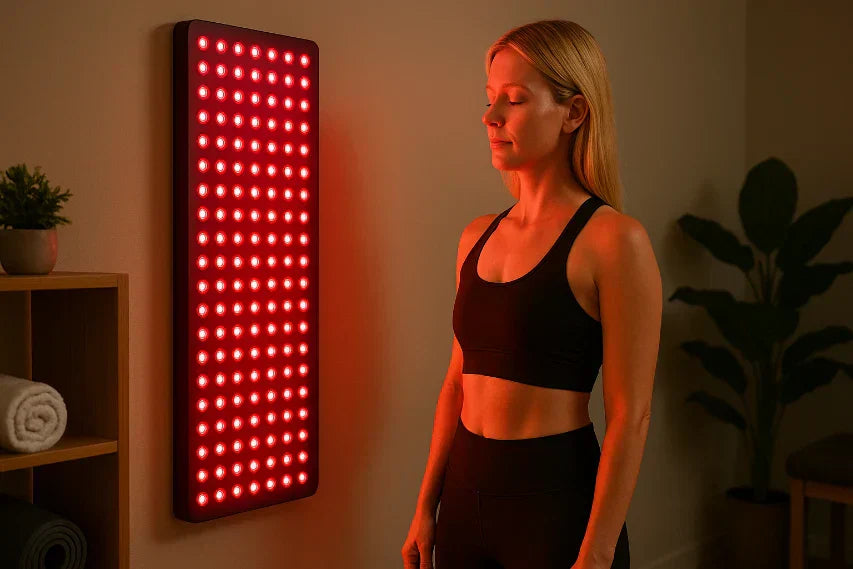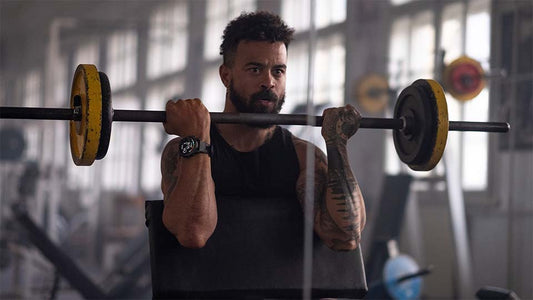Red Light Therapy 2025—Pro Results & Safety Tips
Discover how red / near-infrared photobiomodulation boosts ATP, collagen, recovery, mood, and pain relief. Compare devices, protocols, safety tips, and pro-vs-home costs in one evidence-packed guide with quick science snapshots and benefit tables.

Table of Contents
1. Quick Science Snapshot
Photobiomodulation (PBM) uses photons in the 620 – 675 nm and 760 – 940 nm “optical window” to penetrate tissue, where several intertwined photochemical events unfold:
- Chromophore activation & ATP surge: Red/NIR photons are absorbed by the binuclear heme–copper centers of cytochrome c oxidase, displacing inhibitory nitric oxide (NO) and raising ATP synthesis by ≈ 30 % in vitro[1].
- NO photodissociation & vasodilation: Photoreleased NO diffuses to vascular smooth muscle, activating guanylate cyclase → cGMP → relaxation → ≈ 10 % perfusion gain during a single 10 J cm-2 exposure [2].
- Redox-gene modulation: Transient ROS pulses attenuate NF-κB while activating Nrf2/ARE antioxidant signalling [3].
- Biphasic dose response: PBM follows an Arndt-Schulz curve—beneficial at 4 – 60 J cm-2, neutral beyond ≈ 100 J cm-2, inhibitory at very high fluences [4].
2. Core Benefits (Clinical-Evidence Summary)
| Outcome Target | Effect Size & Protocol | Key Study |
|---|---|---|
| Dermal collagen | +31 % collagen in 8 wks @ 660/850 nm, 96 J cm-2 | [5] |
| Muscle recovery & DOMS | 25 % faster MVC rebound; 30 %↓ CK when PBM pre-workout | [6] |
| Arthritis pain | ≈ 50 % WOMAC-pain drop after 12 sessions, 904 nm pulsed | [7] |
| Cognition & mood | ↑ P300 speed; ↓ Beck Anxiety after 6-week transcranial PBM | [8] |
| Hair regrowth | +14 follicles cm-2 at 24 wks, 633/850 nm helmet | [9] |
Complementary recovery tactics: After your PBM session, contrast-therapy such as a cold plunge or a brief heat exposure in the sauna can amplify blood-flow and lymphatic clearance.
3. Choosing a Device – Engineering Parameters
| Form-Factor | Beam Spec. | Typical Protocol | Notes |
|---|---|---|---|
| Handheld wand | Spot 1–3 cm2, 100 mW CW | 3-5 min ⇒ 18 J cm-2 | Great for acne or scars; pair with targeted mobility drills. |
| LED panel | 30 × 20 cm, 120 mW cm-2 | 10-15 min @ 20 cm ⇒ 72 J cm-2 | Ideal pre-workout priming before glute training. |
| Full-body booth | 8 500 LEDs, 100 mW cm-2 | 12-20 min ⇒ 120 J cm-2 | Systemic recovery; athletes can cross-reference periodised strength programs. |
Engineering tip: Verify NIST-traceable irradiance. Our Pro-Panel X (110 mW cm-2) meets this spec and syncs with the metrics in our Garmin performance-wearable comparison.
4. Safe-Use Checklist
- Ocular shielding: ANSI Z136 goggles covering 400-1400 nm.
- Dose discipline: 4-60 J cm-2 followed by ≥ 48-h rest per site.
- Photosensitizers: Retinoids, doxycycline, amiodarone warrant MD approval.
- Thermal limit: Suspend if skin exceeds 42 °C – a quick check with an IR thermometer (see our equipment-setup guide).
- Hydration & antioxidants: 500 ml water + 500 mg vitamin C within 1 h post-session.
5. Pro-Clinic vs. Home Sessions
| Metric | Professional PBM Suite | Home Panel |
|---|---|---|
| Power Density | 150-200 mW cm-2 | 60-120 mW cm-2 |
| Beam Uniformity | < 10 % variance | < 25 % variance |
| Dosimetry Feedback | On-board meter | Manual distance/time |
| Cost Model | $50-$150 per visit | $249-$1 499 one-time |
Recommendation: Complete 2-3 supervised sessions for calibration, then transition to a calibrated home panel and integrate adjunct recovery (e.g., sauna protocol).
6. Frequently Asked Questions
- When will I notice changes?
- Analgesia can appear within 2 sessions; dermal or hair outcomes need ≥ 8 weeks of consistent dosing.
- Does PBM tan or burn skin?
- No UV photons are emitted; erythema only occurs above 150 J cm-2.
- Can I layer PBM with chemical peels?
- Yes—perform PBM first; wait ≥ 24 h before applying glycolic or TCA acids.
- Is daily exposure safe?
- Yes if each anatomic site receives < 60 J cm-2/day and cumulative weekly fluence stays < 250 J cm-2.
- Pacemaker compatibility?
- LED panels emit negligible EMF; nonetheless inform your cardiologist before use.
7. Key Takeaways
- Red/NIR PBM modulates mitochondrial bioenergetics, vascular tone, and gene transcription with a clear dose-response ceiling.
- Clinical evidence supports its use for skin rejuvenation, muscular recovery, arthritis pain, neuro-cognitive support and hair growth.
- Optimal practice = correct wavelength pair (660 / 850 nm), 4–60 J cm-2, eye protection and hydration.
- My Fitness Outlet provides NIST-verified panels and protocol guidance for home or clinic deployment.
References
- Lu S. et al. “Photobiomodulation of Cytochrome c Oxidase by Chronic PBM.” J. Mol. Neurosci. 2022. PubMed
- Sun Q. et al. “Mapping Duration of PBM Action on Cytochrome c Oxidase.” Front. Neurosci. 2023. Frontiers
- Sun Q., Kim O. “Red LED Modulates NF-κB and Oxidative Stress in Keratinocytes.” J. Photochem. Photobiol. B 186, 31-40 (2018). Link
- Huang Y-Y et al. “Biphasic Dose-Response in Low-Level Light Therapy.” Lasers Surg. Med. 2011. PubMed
- Lee S-Y et al. “Red + NIR LED Phototherapy Boosts Collagen Density.” Dermatol. Surg. 2014. PMC
- Ferraresi C. & Hamblin M. “LLLT Enhances Muscle Performance and Recovery.” Photonics & Lasers Med. 2024. PMC
- Bülow H. et al. “Low-Level Laser in Knee Osteoarthritis: RCT.” Clin. Rehabil. 2022. PubMed
- Hamblin M. R. “PBM Therapy on Brain: An Innovative Modality.” Front. Neurosci. 2023. PMC
- Thomas M. et al. “Dual-Wavelength PBM for Androgenetic Alopecia: RCT.” Dermatol. Surg. 2025. PubMed


